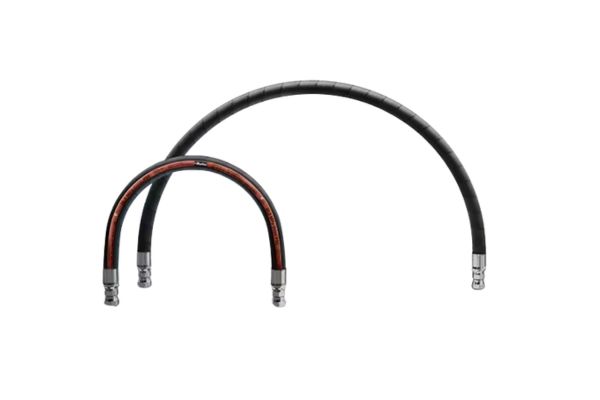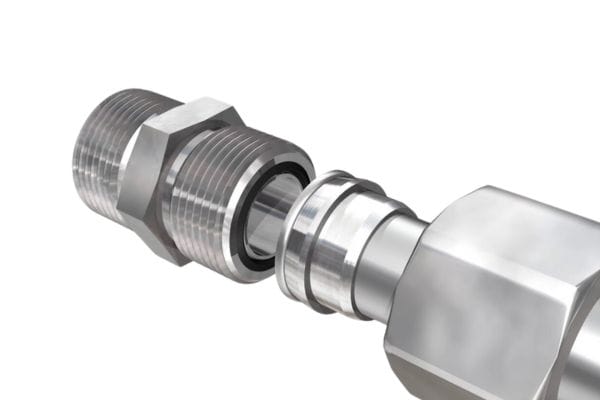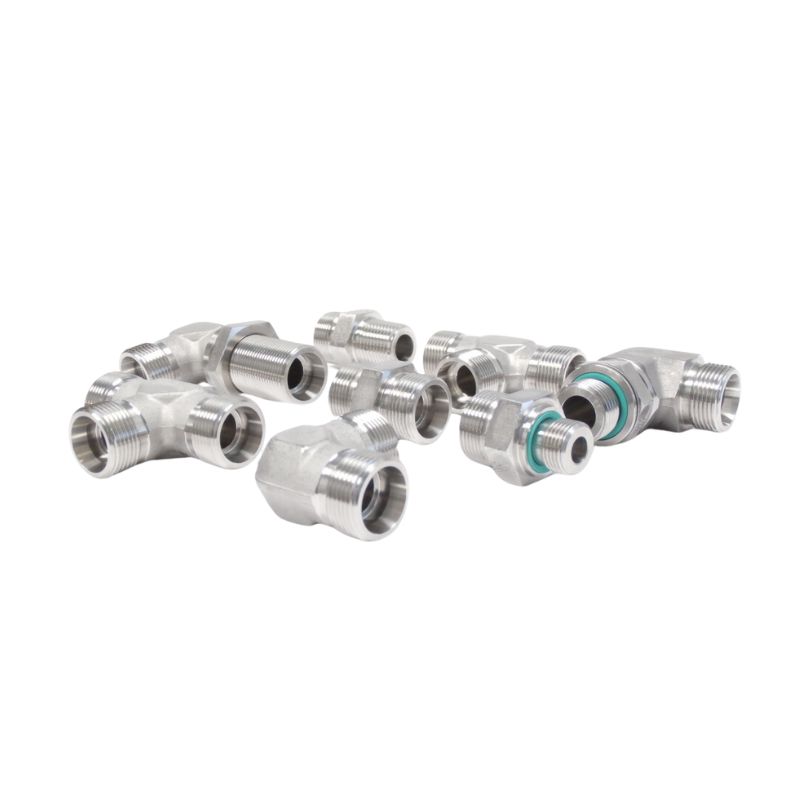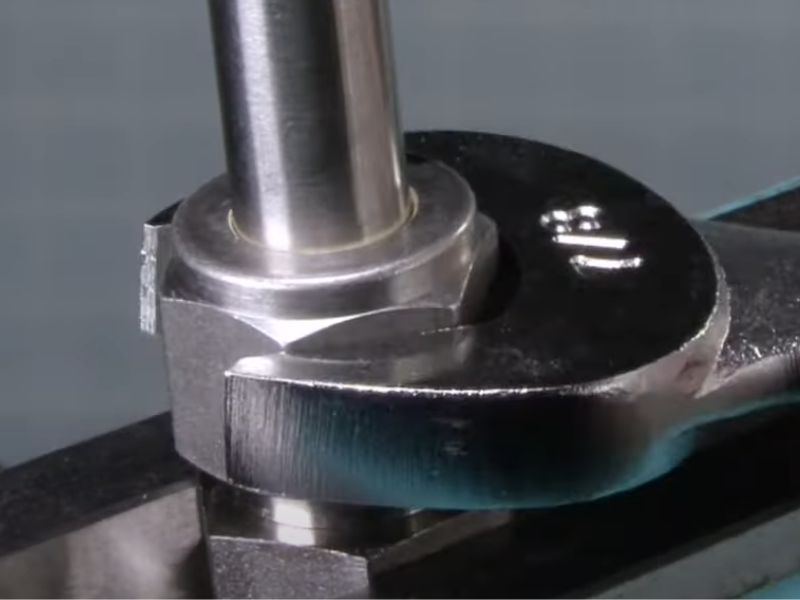Your machinery is shaking, and fittings are failing. This causes dangerous leaks, costly downtime, and constant worry. Proper support is the only way to ensure your system’s safety and reliability.
To secure hydraulic fittings in high vibration, you must use a combination of correct clamping, proper hose routing, and vibration-resistant components. Selecting fittings like O-ring face seals and using cushioned supports are key steps. This prevents loosening, leaks, and premature failure of a hydraulic system.

Working with hydraulic systems for years, I’ve seen how vibration can destroy even the toughest setups. A loose fitting is not just a small leak; it’s a sign of a bigger problem that can shut down an entire operation. Many people think the fitting itself is the only thing that matters. But the real solution is a complete system approach. It starts with choosing the right components and ends with installing them correctly.
What Types of Clamps Best Support Hydraulic Hoses?
Vibrating hoses wear out quickly and cause fittings to leak. This constant movement leads to abrasion, stress at the connection point, and eventual system failure, costing you time and money.
The best clamps for hydraulic hoses in vibrating environments are cushioned clamps. These clamps have a rubber or thermoplastic insert that absorbs vibrations and prevents metal-to-metal contact. This reduces wear and keeps the hose secure without damaging it. Standard clamps and multi-line clamps also have their specific uses.

Choosing the right clamp is one of the most important decisions you can make for system longevity. It’s not just about holding a hose in place. It’s about protecting it from the constant, damaging forces of vibration. A simple, unlined metal clamp can actually make the problem worse by creating a single point of high stress and wear.
Understanding Standard Clamps
Standard clamps, often called P-clamps or U-bolts, are the most basic option. They are usually made of steel or stainless steel. Their main job is to route and secure a hose or pipe to a solid surface. They are simple and inexpensive. However, in high-vibration environments, they have a big drawback. The bare metal can easily chafe the outer cover of a hydraulic hose. This constant rubbing wears away the protective layer, exposing the reinforcement wire to moisture and corrosion. This can lead to a sudden and unexpected hose failure. A customer once used them on a rock crusher, and the hoses failed in weeks.
The Superiority of Cushioned Clamps
Cushioned clamps are the best choice for vibration. They are designed with a soft insert, usually made of an elastomer like EPDM rubber. This cushion does two critical things. First, it absorbs the high-frequency vibrations from the machine, so less energy is transferred to the hose. Second, it grips the hose securely without damaging the outer cover. This prevents abrasion and extends the life of the hose assembly significantly. They cost a little more, but the protection they offer is priceless in demanding applications like construction equipment or industrial machinery.
When to Use Multi-Line Clamps
Multi-line clamps are used when you have several hoses or tubes running parallel to each other. These clamps can be stacked vertically or arranged side-by-side. They provide a very organized and secure way to manage complex hydraulic circuits. They also come in cushioned versions, offering the same vibration-dampening benefits as single clamps. Using multi-line clamps prevents hoses from rubbing against each other, which is another common cause of failure in vibrating systems. Proper organization also makes maintenance and troubleshooting much easier.
Here’s a table to help you decide:
| Clamp Type | Best For | Pros | Cons |
| Standard Clamp | Low-vibration, static applications | Inexpensive, widely available | Can cause hose abrasion |
| Cushioned Clamp | High-vibration environments | Excellent vibration damping, protects hose cover | More expensive than standard clamps |
| Multi-Line Clamp | Multiple parallel hose runs | Organizes complex circuits, prevents hose-on-hose abrasion | Can be bulky, higher initial cost |
How Does Hose Routing Prevent Vibration Damage?
You install a new hose, but it fails just months later. The problem is often poor routing. Hoses that are too tight, bent too sharply, or rub against machine parts are under constant stress.
Proper hose routing is essential for preventing vibration damage. Route hoses with gentle bends and enough slack to absorb movement. Avoid sharp corners and ensure hoses do not rub against each other or machine components. This minimizes stress on both the hose and the fittings.

Give Hoses Enough Slack
A hose that is stretched tight has no room to flex or absorb vibrations. All the movement from the machine is transferred directly to the fittings. This can cause the fittings to fatigue and leak over time. The hose itself is also under constant tension, which can lead to premature failure. A good rule of thumb is to allow enough slack for the hose to move with the machine, but not so much that it can get caught on other components. The hose should be able to flex without being pulled tight at any point in the machine’s cycle of movement.
Use Sweeping Bends, Not Sharp Corners
Every hydraulic hose has a specified minimum bend radius. Bending a hose tighter than this limit can cause it to kink. This restricts flow, increases heat, and can damage the internal reinforcement layers of the hose. In high-vibration applications, a sharp bend creates a major stress point. Always route hoses in wide, sweeping curves. If space is tight, consider using 45-degree or 90-degree elbow fittings. These fittings change the direction of flow without putting any stress on the hose itself. It’s a simple change that can dramatically increase the service life of the hose.
Prevent Abrasion at All Costs
Abrasion is one of the top killers of hydraulic hoses. When a vibrating hose rubs against a metal frame, another hose, or any other object, its outer cover will quickly wear away. Once the steel wire reinforcement is exposed, it will rust and break, leading to a burst hose. You can prevent abrasion by using clamps to secure the hose away from any moving parts or sharp edges. For areas where contact is unavoidable, you should use protective sleeving.
Here’s a simple checklist for routing:
- Do: Allow for sufficient slack.
- Do: Use wide, sweeping bends.
- Do: Use clamps to secure hoses away from moving parts.
- Do: Use protective sleeves in high-abrasion areas.
- Don’t: Pull hoses tight.
- Don’t: Exceed the minimum bend radius.
- Don’t: Let hoses rub against each other or the machine frame.
Which Fittings Are More Resistant to Vibration?
Your standard fittings keep loosening, causing leaks and downtime. You tighten them again, but the problem returns. The constant vibration is simply too much for metal-to-metal seals.
O-ring face seal (ORFS) fittings are far more resistant to vibration than standard metal-to-metal fittings like JIC. The ORFS design uses a soft elastomeric seal that absorbs vibration and maintains a leak-proof connection, even under intense shaking.

The Problem with JIC Fittings in Vibration
JIC fittings create a seal by forcing two metal cones together. This metal-to-metal seal is effective in static applications. However, under vibration, the parts can slowly move relative to each other. This movement, called fretting, can wear down the sealing surfaces. It also allows the fitting to loosen over time. Even if you torque a JIC fitting perfectly, constant vibration will work against it.
The Advantage of O-Ring Face Seal (ORFS)
ORFS fittings solve the vibration problem with a simple, brilliant design. The fitting has a flat face with a groove that holds an O-ring. When you tighten the fitting, this O-ring is compressed against the flat face of the mating fitting or adapter. This creates a soft seal. The elastomeric O-ring acts like a small cushion, absorbing vibrations and maintaining a tight seal even as the machine shakes. The mechanical connection holds the parts together, while the O-ring does the sealing. This separation of roles is what makes it so robust. The connection can handle much higher pressures and is virtually leak-proof in high-vibration environments.
Comparing Sealing Technologies
Let’s look at how these two common fitting types stack up when dealing with vibration. This comparison makes it clear why one is superior for tough jobs. We have helped many clients switch from JIC to ORFS and completely eliminate their recurring leak problems.
| Feature | JIC (37° Flare) | ORFS (O-Ring Face Seal) |
| Sealing Method | Metal-to-Metal Cone | O-Ring to Flat Face (Soft Seal) |
| Vibration Resistance | Fair to Poor | Excellent |
| Leakage Risk | High, especially after re-assembly | Very Low, almost zero-leak |
| Torque Sensitivity | Very sensitive to over/under-tightening | Less sensitive, provides better feedback |
| Reusability | Limited, sealing surface can be damaged | Excellent, just replace the O-ring |
| Cost | Lower | Higher |
While ORFS fittings do have a higher initial cost, the long-term savings from reduced downtime, no fluid loss, and lower maintenance make them a smarter investment for any vibrating system.
Can Damping Materials Really Make a Difference?
You’ve used the right clamps and fittings, but you still see wear and tear from severe vibrations. The shaking is just too intense for the clamps alone to handle.
Yes, damping materials make a huge difference. Materials like rubber mounts and isolation pads absorb vibration energy before it reaches the hydraulic hoses and fittings. This drastically reduces mechanical stress and protects the entire system from fatigue and failure.

Think of it like the suspension in your car. Without it, you would feel every single bump in the road. Damping materials work in a similar way for your hydraulic system. They isolate it from the raw, damaging vibrations of the engine or the machine frame. This is a next-level solution for the most extreme environments. We have seen this approach used in mining equipment and marine applications, where engine vibration is constant and powerful. It adds another layer of protection that can be the key to long-term reliability.
Using Rubber Isolation Mounts
Isolation mounts are one of the most effective ways to dampen vibration. You can install them between a machine’s frame and a major hydraulic component, like a pump or motor. The mount is typically a block of rubber bonded between two metal plates. This rubber absorbs the vibrations from the machine, preventing them from being transferred to the hydraulic component and the attached hoses. When the pump or motor is isolated, the hoses connected to it experience much less shaking. This significantly reduces stress on the fittings and hose crimps.
The Role of Damping Pads
Damping pads are sheets of viscoelastic material that can be applied directly to flat surfaces on a machine. When a panel vibrates, the damping pad moves with it and converts the vibrational energy into a tiny amount of heat. This process, known as viscoelastic damping, effectively quiets down noisy panels and reduces the overall level of vibration in the surrounding area. While not a direct support for a hose, reducing the source vibration makes the job of clamps and fittings much easier.
Advanced Cushioned Clamps and Supports
We already discussed cushioned clamps, but it’s worth looking at their materials. The choice of cushion material matters. Standard EPDM rubber is good for general use. For higher temperatures, silicone is a better choice. For exposure to aggressive chemicals, a Viton cushion might be necessary. Some advanced clamp designs use a dual-durometer cushion. This means it has a harder outer layer for durability and a softer inner layer for maximum vibration absorption.
Here are some key benefits of using damping materials:
- Extends Component Life: Reduces fatigue on fittings, hoses, pumps, and motors.
- Reduces Noise: Lowers the operating noise level of the machine, improving worker safety and comfort.
- Prevents Loosening: Helps keep all threaded fasteners, not just hydraulic fittings, from backing out.
- Improves System Reliability: Drastically cuts down on leaks and failures caused by vibration.
What Are the Steps for a Vibration-Proof Installation?
You have all the right parts, but a sloppy installation can ruin everything. If torque is wrong or supports are misplaced, your system is still at risk from vibration damage.
A vibration-proof installation involves a systematic process: inspect the system, select the right vibration-resistant components, apply lubricant, use a torque wrench for precise tightening, and finally, secure all lines with appropriate cushioned clamps and supports.
Step 1: Thorough Inspection and Planning
Before you touch a single tool, inspect the entire hydraulic path. Identify the sources of vibration. Look at the machine’s moving parts. Plan your hose routes carefully to avoid abrasion points and sharp bends. Make a list of all the components you will need: the right fittings (preferably ORFS), the correct hose length and type, cushioned clamps, and any necessary protective sleeves.
Step 2: Component Preparation and Lubrication
Cleanliness is critical. Make sure the threads and sealing surfaces of all your fittings are perfectly clean. Any dirt or debris can compromise the seal. For flare fittings and threaded connections, apply a small amount of system-compatible lubricant or hydraulic oil to the threads and sealing surfaces. This is very important. Lubrication prevents galling (thread damage) and allows you to achieve the correct torque, which ensures the proper preload on the connection. For ORFS fittings, make sure the O-ring is new, clean, and lightly lubricated.

Step 3: Precise Torque Application
Do not guess at tightness. Use a torque wrench. Every fitting manufacturer, including Topa, provides torque specifications for their products. Under-tightening will allow the fitting to leak and loosen under vibration. Over-tightening can damage the threads or crush the O-ring, also causing a leak. Tighten the fitting to the specified value. For flare fittings, you might tighten by hand until snug, then use a wrench to turn a specific number of “flats” on the nut. For ORFS, tighten until you feel a solid increase in resistance. This indicates the O-ring is fully compressed.
Step 4: Final Securing and Support
Once all your fittings are correctly torqued, the final step is to secure the hoses. Install your cushioned clamps at regular intervals. The spacing will depend on the hose diameter and the intensity of the vibration, but a good starting point is every 12 to 24 inches. Ensure the clamps are tight enough to hold the hose firmly but not so tight that they deform it. Your hoses should be neatly routed, free from rubbing, and have enough slack to flex without stressing the fittings.
How Often Should You Inspect Fittings in Vibrating Systems?
You’ve installed your hydraulic system perfectly, but you can’t just forget about it. Vibration is a relentless force. Over time, even the best installations can develop problems.
You should inspect hydraulic fittings in high-vibration systems frequently. A daily visual check is recommended, with a more detailed hands-on inspection and torque check scheduled weekly or monthly, depending on the severity of the vibration and the machine’s operating hours.
Creating a Pre-Operational Checklist
For critical machinery, operators should perform a quick visual inspection before every shift. This is a simple walk-around to check for obvious problems. It doesn’t need to be complicated. The operator should be trained to look for:
- Visible Leaks: Any drips, puddles, or shiny wet spots on or under the machine.
- Hose Damage: Look for blisters, cracks, or visible abrasion on hose covers.
- Loose Components: Check if any clamps or supports look loose or out of place.
- Unusual Noise: Listen for any new hissing sounds that could indicate a pressure leak.
This daily check takes only a few minutes but can catch a problem before it becomes serious.
Scheduled Maintenance Intervals
A more thorough inspection should be done on a regular schedule. The frequency depends on how hard the machine works.
| Application Severity | Recommended Inspection Interval | Actions |
| Extreme (e.g., Rock Crushers, Jackhammers) | Weekly | Visual check, check torque on critical fittings, look for wear. |
| High (e.g., Excavators, Dozers) | Monthly | Full system inspection, check torque on all accessible fittings. |
| Moderate (e.g., Factory Conveyors, Generators) | Quarterly | Full system inspection, spot-check torque on fittings. |
During these scheduled inspections, a technician should physically touch and feel the lines (when the system is off and de-pressurized). They should check the tightness of clamps and mounts. They should also re-check the torque on key fittings using a torque wrench.
Signs of Loosening or Wear
You need to know the early warning signs of a potential failure. Train your team to look for these subtle clues:
- Weeping Fittings: A fitting that isn’t dripping but has a constant build-up of dirt and grime stuck to a thin film of oil. This is a sign of a very slow leak.
- Polished or Worn Spots: Shiny spots on a hose, fitting, or machine frame indicate that parts are rubbing together. This is an abrasion point that needs to be addressed immediately.
- Twisted Hoses: A hose that appears twisted is under stress and can fail prematurely. This is often a sign of improper installation.
- Corroded Wires: If you see any rust on the wire reinforcement layers of a hose, that section of hose is compromised and should be replaced.
Conclusion
Securing hydraulic fittings against vibration requires a total system approach. By using the right clamps, fittings, and routing techniques, you can build a reliable, leak-free system that lasts.
FAQ
What clamps work best for hydraulic hoses in vibration?
Cushioned clamps with rubber or thermoplastic inserts are best because they absorb vibration and prevent hose abrasion.
Why do standard clamps fail in high-vibration systems?
Standard clamps have bare metal edges that rub against hose covers, causing abrasion and early failure.
Which fittings are most resistant to vibration?
O-ring face seal (ORFS) fittings resist vibration better than JIC fittings because their soft seal absorbs movement.
How should hydraulic hoses be routed to prevent damage?
Route hoses with sweeping bends, allow some slack, avoid sharp corners, and use clamps to prevent rubbing.
Do damping materials really reduce vibration damage?
Yes, rubber isolation mounts and damping pads absorb vibration energy and reduce stress on hoses and fittings.
How often should fittings in vibrating systems be inspected?
Daily visual checks are recommended, with weekly or monthly torque checks depending on vibration severity.





